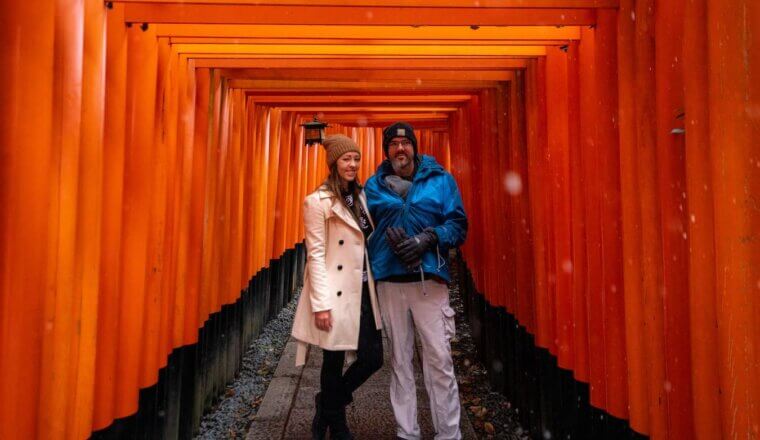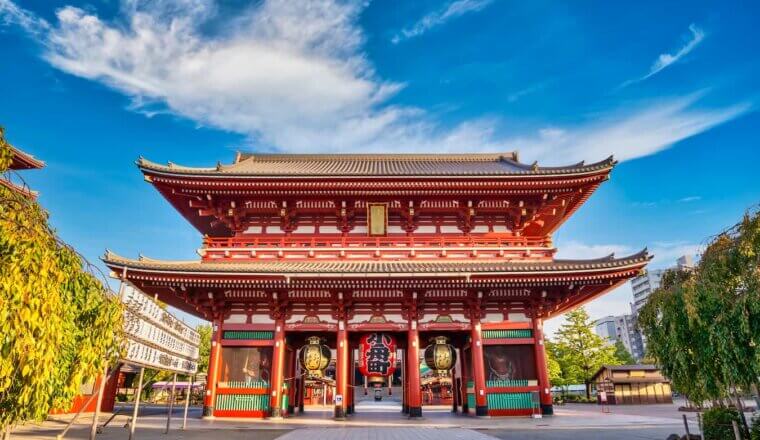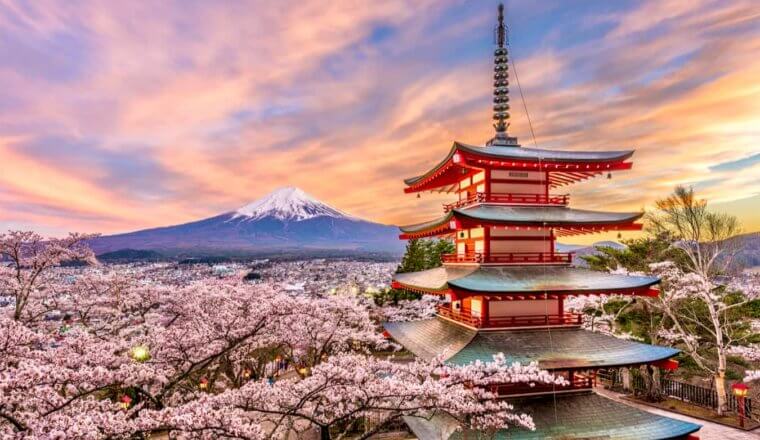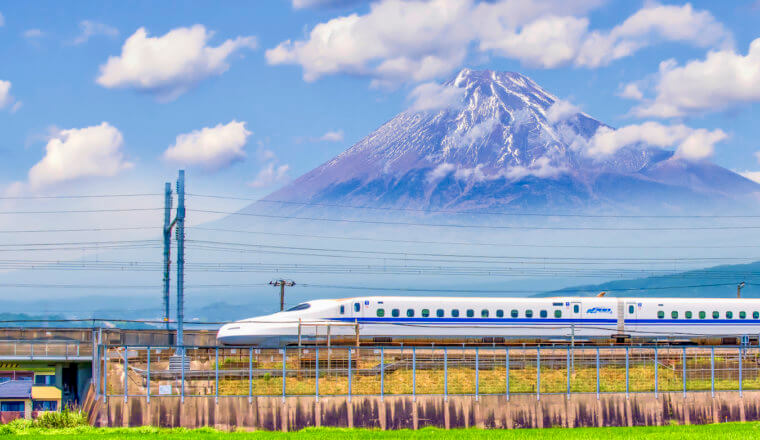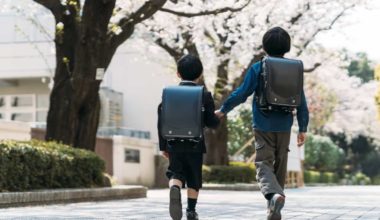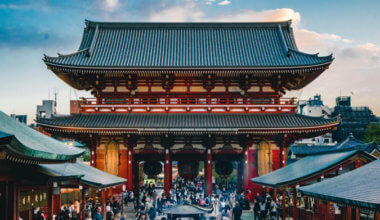Japan is one of the most amazing, beautiful, interesting, and friendly countries in the world. From bustling Tokyo and Zen-like Kyoto all the way to laid-back Okinawa and wintery Hokkaido, Japan rocks. It boasts mouthwatering food, majestic temples and shrines, serene gardens, lush national parks, and a rich culture.
It was a lifelong dream to go there, and, when I finally did, it lived up to all my expectations. Since then, I’ve been there over five times and will probably keep going back. There’s just so much to do there, and I love the food and culture.
A lot of people delay or skip Japan, because they think it’s super expensive. And while some aspects of traveling there are expensive, there are plenty of ways to make it affordable. I was actually shocked how easy it was to see Japan on a budget.
This Japan travel guide can help you plan an affordable trip so you can see more, eat more, and spend less.
Table of Contents
Click here for City Guides
Top 5 Things to See and Do in Japan
1. Explore Tokyo
Tokyo is one of the best cities in the world. Here you will find shrines, palaces, temples, hip clubs, fancy cocktail bars, weird fashion, and of course, incredible people. Tokyo is a fast paced, futuristic city. Be sure to also hit some of the quirky themed cafés, wander the Harajuku district, walk across the iconic Shibuya crossing, and admire the Imperial Palace. Visit my detailed guide for more information.
If you don’t want to explore alone, take a guided walking tour to get the lay of the land and connect with a local guide who can answer all your questions.
2. Wander Kyoto
Boasting beautiful temples and Japanese gardens, Kyoto is one of the most popular destinations in Japan. It retains much of the traditional lifestyle and is a good juxtaposition to fast-paced and high-tech Tokyo. See as many temples as possible, wander the bamboo forest (just get there early to beat the crowds), and eat your way through town.
3. See Hiroshima
In 1945, the first atomic bomb to be used in combat was detonated in Hiroshima. Around 80,000 people were killed instantly, and tens of thousands more died afterward due to radiation exposure. Visit the atomic bomb memorial and learn about one of the most controversial events of human history. The museum is sobering and eye-opening, but a must-see if you want to understand modern Japan. You can also take a cycling tour around the city to learn more about the bombing and its aftermath.
4. Climb Mount Fuji
This 3,776-meter (12,389-foot) mountain is located near Tokyo, and it makes for a worthy challenge. During the day, fog and clouds often cover the mountain, so ascents tend to happen early in the morning or overnight. But the lack of sleep is worth the jaw-dropping sunrise. Keep in mind that the climbing season is short, from early in July to mid-September. If you’re visiting outside of the climbing season or just don’t want to hike the mountain, there are many tour providers that offer day trips from Tokyo from around 12,000 JPY.
5. Visit Sapporo
The gateway to Japan’s northern island of Hokkaido, this city is famous for its surrounding mountains, thermal baths, ski resorts, and lengthy beer brewing history. Hosting the 1972 Olympic Winter Games put the city on the international map, and it remains hugely popular for its cold-weather sports. It’s also home to the hugely popular Sapporo Snow Festival, where you can see world-class ice and snow sculptures each February (over two million people attend!). Don’t miss the Beer Museum, and be sure to take the train to the coastal town of Otaru for uni (which is harvested there).
Other Things to See and Do in Japan
1. Visit the Tsukiji and Toyosu fish markets
Tokyo’s fish markets start bright and early at 4am. Here you can see the frenzied buying and selling of the world’s largest tuna market. Tsukiji was the original market but, as of 2018, the inner fish market moved to Toyosu and is now known as the Toyosu Fish Market. However, the outer market (where you can find food and shops) is still in place at Tsukiji, of which you can take a guided tour to learn about its history, how it works, and even learn how to roll sushi in a workshop at the end.
2. Spend a day in Kyoto’s Gion District
Otherwise known as the Geisha District, this neighborhood is filled with fascinating historic architecture and is a good area for window shopping. Geishas (traditional professional entertainers) have worked here for centuries, and if you’re lucky, you may be able to spot one going to or from a social engagement at one of the establishments. (Just note that photographs are forbidden on the narrow alleys to prevent harassment of the geishas.) You can also take a nighttime walking tour.
3. Explore Nara
Located just one hour from Kyoto, Nara is famous for its 1,300 “wild” deer that freely roam Nara Park. The Japanese consider deer to be messengers of the gods, so they are free to roam the city (their horns are cut short, so they can’t hurt people). There are vendors selling crackers all around the park, so you can feed them by hand. While here, be sure to take in the world’s largest wooden building, Todai-ji, which dates to the eighth century and was reconstructed in the 1700s. Most travelers visit Nara as a day trip from Kyoto, but I suggest staying at least a night to really see everything.
4. See Osaka
Osaka is the third-largest city in Japan and its financial heart. It’s also a big foodie hub. Mouthwatering sushi and sashimi, Kobe beef, Japanese barbecue, and flavorful ramen can all be found here in abundance. There’s also popular specialties like okonomiyaki (a savory pancake with egg and vegetables) and kushikatsu (skewered kebabs). You can take a food tour for around 12,000 JPY or just wander and eat.
Beyond the food, don’t miss Osaka Castle. While it’s not the original (this version dates to 1931), it’s nevertheless an impressive sight. It’s home to a small but insightful museum and an observation deck that offers some picturesque city views.
6. Relax in Ueno Park
Established in 1873, Tokyo’s Ueno Park is a great place to spend the day for free. Pack a lunch and bring a camera, as it’s a perfect spot to record the many cherry blossom trees (April is the best time of year if you hope to catch them in full bloom). You can also take a three-hour architecture tour around the park, ending at the Tokyo National Museum, where you can then go inside to explore the collections on your own. Also in the park is a zoo, art center, and art museum.
7. Admire the Imperial Palace
The Imperial Palace is home to the emperor of Japan (whose lineage stretches back over a thousand years). It was built on the site of the former Edo Castle, which was originally constructed in the 15th century. Today, the Imperial Palace is a perfect spot to learn about some of Japan’s history and culture. Though you can’t go inside the palace itself, the surrounding grounds and park are beautiful, and you can watch the changing of the guard. You can visit select parts of the grounds on a 75-minute guided tour at 10am and 1:30pm Tuesday-Saturday. The Imperial East Gardens are free and open daily except Mondays, Fridays, and holidays.
8. Visit Miyajima Island
Miyajima is a UNESCO World Heritage Site located about an hour outside of Hiroshima, known as “Shrine Island” because of its temple and iconic floating torii gate. Itsukushima Shrine, the main one here, dates back to the 12th century. There’s also a five-story pagoda that dates back to the 15th century, and the tranquil Momijidani Park, one of the most beautiful maple valleys in the country. And, like Nara, there are plenty of deer here too. A trip to the island can easily be made into a full day if you hit the walking trails nearby. And be sure to hike up Mount Misen — it’s a great workout, and the views are stunning! There is also a cable car to the peak you can take for 2,000 JPY round-trip.
9. Tour Bitchu Matsuyama Castle
At 430 meters (14,100 feet), not only is this Japan’s highest castle but it’s also its only remaining original one (most were destroyed in fires or during World War II). The castle was originally built on a nearby mountain in 1240 by Akiba Shigenobu. In 1929, restoration work began, and it is now a popular tourist site. Admission is 500 JPY for just the castle or 1,000 JPY for the castle, temple, and nearby samurai houses. If you’d like to patronize the Takahashi Folk Museum and Yamada Hokoku Museum, the entire combined ticket costs 1,500 JPY.
10. Go on pilgrimage
The 88 Temple Pilgrimage (also known as “Shikoku Henro”) is an ancient route that circles the island of Shikoku, one of Japan’s four main islands. Under consideration for UNESCO status, the route stretches 1,200 kilometers (745 miles) and can take between 30 and 60 days. It’s one of the only circular pilgrimages in the world, with roots dating back over a thousand years. Between 150,000 and 200,000 people do the hike each year. In addition to the 88 official temples, there are also 20 additional sites you can visit as well. You can, of course, just go to some of the temples and not walk the entire trail!
11. Explore Nikko
Located two hours north of Tokyo in the mountains, Nikko has welcomed worshippers of both Buddhist and Shinto traditions for centuries, so there are many temples and shrines in the woods to visit. Nikko is also the home of the imperial summer palace (the only imperial residence opened as a museum) and the resting spot of Tokugawa Ieyasu, the first shogun of Tokugawa Shogunate (1603–1868). The shrine dedicated to him is beautiful. You’ll also find lots of waterfalls in the area and a beautiful lake to go boating on. The trails at nearby Nikko National Park offer excellent hiking. In short, Nikko is a really nice destination for two or three nights.
12. Stay in a ryokan
A ryokan is a traditional Japanese bed-and-breakfast, usually found in the more scenic regions. They date back over 1,200 years and are known for their traditional tatami floors, communal baths, and sliding doors, and cozy interiors. Ryokans make for an intimate and unique Japanese experience, featuring included meals and traditional Japanese robes (called yukata). Beds are traditional futons, and there is usually a common area where you can make tea and chat with the owner.
13. Soak in an onsen
Natural hot springs are widespread throughout the country, and can be found both indoors and outdoors. They are a great way to “soak in” some traditional Japanese culture. Each has a different mineral composition. Expect to pay around 1,000 JPY for a budget bathhouse. (Just note that many do not allow people with tattoos or require tattoos to be covered. They are also separated by gender.)
14. Explore Daisetsuzan National Park
If you make it all the way up to Hokkaido (the northern prefecture of Japan and second-largest island), be sure to spend some time exploring Daisetsuzan (“Great Snowy Mountains”) National Park. Located around two hours from Sapporo, the park offers numerous trails, and some of the most rugged and beautiful landscapes in the country. It’s also one of the last remaining places in Japan to see brown bears. The most popular hike here is Mount Asahidake, a challenging volcano that takes 3-4 hours. The park is a far cry from the tourist trail and usually just sees Japanese visitors, so you’ll get to enjoy a spot locals favor.
15. Relax in Okinawa
If you need a break from the fast pace of Japan, hop on down to Okinawa Prefecture, considered “the Hawaii of Japan.” Life proceeds at a much slower pace here, and the climate is subtropical. Even Naha, the biggest city in the region, is laid-back. Okinawa is famous for its diving opportunities off the coral reefs, as well as World War II sites and memorials. Karate was also created here over 700 years ago.
From Okinawa Honto (the main island), you can hop to other smaller islands by ferry, including some that are very remote and rarely see visitors (such as Iriomote or Kume). Camping, whale watching, and hitting the beach are some of the most popular activities here.
16. Admire Kanazawa
Located on the west coast, Kanazawa is known for its incredibly well-preserved Edo-era (1603–1868) districts (the final period of traditional Japan). Home to under 500,000 people, the city is called “Little Kyoto” — but without the oppressive crowds. I think this is a really nice, off-the-beaten-path destination. Make sure to see Tsuzumi-mon Gate, admire Kanazawa Castle, and explore the geisha districts and samurai district (Nagamachi), where numerous preserved houses remain.
17. Hike in the national parks
Japan may be a small country but it’s preserved a lot of its natural landscapes. There are 34 national parks, each offering respite from the hectic and dense cities that Japan is known for. Nikko (mentioned above) is best for seeing fall colors; Daisetsuzan (also mentioned above) has lots of remote onsen and challenging trails; Keramashoto, located in Okinawa, has some of the best islands and beaches, as well as over 250 types of coral; and Yoshino-Kumano is famous for its cherry blossoms. There are a lot of parks to choose from! Try to see at least one!
18. Visit Takashima
Home to just 50,000 people, Takashima boasts castle ruins, plenty of old shrines and Buddha statues, and a picturesque floating torii gate (similar to the one in Miyajima). There’s also a four-kilometer (2.5-mile) walking route lined with cherry trees. Moreover, this town is famous for its Hida beef, which I think is the best beef in all of Japan.
For information on specific cities in Japan, check out my city guides below:
Japan Travel Costs
Accommodation – Expect to spend 2,500-4,500 JPY per night for a dorm room in a hostel. Capsule hotels cost 3,000-5,500 JPY for a tiny pod that’s essentially just a bed. It’s not fancy, but it’s a unique (and very Japanese) experience. For budget hotels, expect to spend 6,000-10,000 JPY per night for a double room in a basic hotel. For Western hotel chains, expect to spend around 20,000 JPY or more per night. Note: For accommodation in Tokyo, add 50% to all these prices.
Airbnb is heavily regulated in Japan and, as such, there aren’t too many options. What rooms are listed are mostly hotels and guesthouses. Private homes/apartments usually start around 15,000-20,000 JPY per night, while private rooms (i.e., hotel rooms) run 8,000-10,000 JPY per night and up.
If you are looking for a more unique experience, consider staying at a ryokan, a traditional Japanese bed-and-breakfast. While they are more expensive than a standard hotel, it’s a unique and memorable experience, as you’ll get to sleep on traditional futons and tatami mats.
Food – Japanese cuisine is world-renowned and has even earned a spot on UNESCO’s Intangible Heritage List. While each region has its own specialties, rice, noodles, seafood, and seasonal produce all feature heavily no matter where you are.
Food in Japan is relatively inexpensive so long as it’s not imported (fresh fruit will set your budget back!). The most common cheap eats are using curry, donburi (bowls of meat and rice), or ramen. Curry and donburi bowls cost 500-700 JPY, while ramen or soba noodles are usually around 1,200 JPY.
Fast food (think McDonald’s) is around 800 JPY for a set menu. You can also find plenty of cheap meals and prepackaged items at 7-Eleven (locals actually get a ton of food here — it’s a thing). Noodles, rice balls, tofu, and prepackaged sushi are all available for only 250-500 JPY.
Most sit-down restaurant meals are going to cost you 2,000-3,000 JPY. Sushi conveyor belt restaurants (which are super fun) will run you 125-620 JPY per piece.
Fine dining is a tradition rooted in Japanese culture, and kaiseki ryori is a style of high-end, multicourse Japanese dining that originated in Kyoto. It costs about 8,000-10,000 JPY for a set menu of seven courses, covering everything from chicken to Wagyu steak to sushi.
High-end omakase restaurants (where dishes are selected by the chef) will set you back at least 10,000 JPY, though more likely closer to 20,000 JPY. (In Tokyo, the best ones are 30,000 JPY.)
Domestic beer is around 450-550 JPY, and sake is about 800-900 JPY per glass. A cocktail will set you back about 1,200 JPY. A latte or cappuccino is 500-600 JPY, and a bottle of water is 100-130 JPY.
Buying groceries costs around 5,000-6,000 JPY per week for basic staples like rice, vegetables, and fish. However, given the availability of such cheap food, it’s doubtful you’ll go grocery shopping to prepare your own meals.
Backpacking Japan Suggested Budgets
If you’re backpacking Japan, plan to budget 7,000 JPY per day. This assumes you’re staying in a hostel dorm, cooking some of your meals, eating at the cheap 100-yen shops, visiting free museums and temples, and using public transportation to get around.
On a more midrange budget of 16,000 JPY per day, you can stay in nicer accommodations and private rooms, eat out more liberally, indulge in more drinks, visit more attractions, and, overall, just have some more breathing room in your travels!
On a “luxury” budget of 28,000 JPY per day or more, you can stay in traditional Japanese accommodations or two-star hotels, eat at nicer restaurants each day, splurge on some meals, enjoy drinks as often as you want, take tours, and, overall, just afford whatever you want!
Japan Travel Guide: Money-Saving Tips
I think Japan’s reputation as an expensive country is overstated. Outside of accommodation and transportation, it’s actually really affordable. Is it super cheap? No. Is it super expensive? Not at all. There are plenty of ways to lower your costs and all non-imported food is really inexpensive. Here are some ways to save money when you visit:
- Visit the free attractions – With its countless museums, shrines, temples, historic neighborhoods, and parks, Japan is filled with opportunities to immerse yourself in its culture withouts spending a Yen. Moreover, many of the nation’s parks are also free. Start with them and you’ll fill your days on the cheap!
- Get a JR Pass – The bullet trains in Japan are ridiculously expensive, with one-way fares costing hundreds of dollars. If you plan to do a lot of traveling around the country, get the JR Pass, which allows you unlimited train travel and can save you a ton of money. It comes in 7-, 14-, and 21-day options. (Keep it mind it can only be purchased outside of Japan, so be sure to plan ahead.)
- Take the bus – Buses are a far more economical option than the trains. They cost a fraction of the price. For example, the unlimited Japan Rail Pass costs 29,650 JPY for seven consecutive days of travel, but this is far more expensive than using the bus. But buses take a lot longer. For example, the two-hour bullet train ride from Tokyo to Osaka becomes a 10-hour bus ride. Bottom line: if you have the time, take the bus.
- Shop at the 100-yen stores – There are many 100-yen shops around the country. They all sell meal sets, groceries, water bottles, toiletries, and household items. Store names vary by region, so ask your hotel or hostel reception where the nearest “Hyaku En” store is located.
- Eat at 7-Eleven – 7-Eleven, Family Mart, and other convenience stores have a lot of pre-made meals that make for a cheap lunch or snack. The food is actually really good and you’ll always see locals dipping in and getting a quick lunch or snack here. Don’t be afraid to at them.
- Cook your own food – Many hostels have kitchens where you can cook your own meals. Combining this with shopping at the 100-yen stores will drastically cut your food costs.
- Eat curry, ramen, and donburi – These dishes are the best option for eating cheap, filling meals. These cost from 400 – 1200 Yen (Ramen is 1200). Shops specializing in these dishes are all over the country. They’re delicious and affordable!
- Stay with a local – Using hospitality sites like Couchsurfing allows you to stay with residents, so you not only get a free place to stay but you get to interact with someone who can share their insider tips.
- Buy food before grocery stores close – After 8pm, many supermarkets discount their fresh food, as they have to get rid of it by law. You can save up to 50% on almost all ready-made meals.
- Hitchhike – Japan is one of the world’s safest countries, and many locals are curious enough to pick up foreign visitors. Hitchhiking isn’t really practiced by Japanese, so you will stand out as a tourist, which will increase your chances of finding a ride.
Where to Stay in Japan
Japan has lots of hostels, though they are mostly in the larger cities. Here are some suggested places to stay around the country:
- Hostel Chapter Two Tokyo (Tokyo)
- K’s House (Tokyo)
- Jiyujin (Kyoto)
- Backpacker Hostel K’s House Kyoto (Kyoto)
- Len Kyoto (Kyoto)
- The Pax Hostel Records (Osaka)
- Roku Hostel Hiroshima (Hiroshima)
- WeBase HAKATA Hostel (Fukuoka)
How to Get Around Japan
Public transportation – Metro or bus tickets cost 150–300 JPY for a single journey. (The price varies by distance and may often be higher.) Fares are usually around 220 JPY to travel across Tokyo but less for shorter distances. In most major cities, you can buy a day pass, which gives you unlimited travel for 24 hours for around 800-1,100 JPY.
Trains – The bullet train is awesome, comfortable, and super fast — but it’s not cheap. Individual tickets can cost hundreds of dollars. In order to reduce your train costs, get a Japan Rail Pass, which is indispensable for travel here.
Even if you just get the seven-day pass, it’s the same price as a round-trip train ticket from Osaka to Tokyo. Moreover, the JR trains also serve urban areas and so can be used within cities. I used my pass to get around Kyoto and Tokyo instead of buying metro tickets.
So, even if you aren’t going to do much traveling around Japan, buying a pass is better than buying individual tickets. While the high price of the pass can cause sticker shock, the alternative is worse.
Be sure to download the Navitime app, which can help you get around. It has offline maps, train and public transit routes, and info on train stations. It’s a lifesaver when trying to figure out how to get around the country.
Buses – Buses are a less expensive alternative to the bullet train system in Japan, but they take more time. For example, the two-hour bullet train ride from Tokyo to Osaka becomes a ten-hour bus ride. The price for that seat is 4,500-8,000 JPY, but at some point, you need to think about how much your time is worth.
There are also bus passes that offer unlimited travel and begin at 10,200 JPY for three nonconsecutive days of travel. You can use these two websites to book your bus journeys:
If you have lots of time and no money, take the bus. Otherwise, I’d say splurge and take the train, because they really are much faster and much, much more comfortable.
Flying – In general, flight prices are on par with bullet train tickets. ANA, the main carrier, offers special last-minute fares via a hidden page on its website, usually for around 14,000 JPY for a seat. It’s only available to foreigners and can sometimes be cheaper than the flights you find on Skyscanner, especially for longer routes around the country.
Generally, unless you’re going up north or down to Okinawa, you won’t need to fly. Flights from Tokyo to Okinawa are around 23,000 JPY (round-trip) while those from Tokyo to Sapporo are around 16,000 JPY (round-trip).
Car rental – With efficient public transportation and nationwide bullet trains, renting a car here really isn’t necessary. However, if you do need one, multiday rentals start at 6,000 JPY per day. Just remember that people drive on the left here!
For the best car rental prices, use Discover Cars.
Hitchhiking – Japan is one of the world’s safest countries, and many locals are curious enough to pick up foreign visitors. Hitchhiking isn’t really practiced by the Japanese, so you will stand out as a tourist, which will increase your chances of finding a ride. Most people don’t speak much English, though, so prepare accordingly and download a language app. For more tips, use Hitchwiki.
When to Go to Japan
Temperature and weather varies drastically across Japan, meaning it’s always a good time to visit some part of the country. While most of Japan does have four seasons (including snowy, freezing winters in the north), Okinawa and the islands in the south are warm year-round. It gets cold in Tokyo, but it generally doesn’t snow.
Expect warm, humid weather from June through August, with temperatures hovering around 32°C (89°F). Japan also gets a lot of rain, mostly in the summer months, from mid-June to mid-July. It gets a little drier in August, before the precipitation picks up again in September. Typhoon season occurs from May to October. Japan is well-equipped to handle all types of typhoons, but be sure to purchase travel insurance in advance!
Overall, there’s no real bad time to visit. Winter is awesome for skiers or snowboarders, spring is famous for its cherry blossoms, summer is full of festivals, and fall has brilliant autumn colors and nice temperatures. I personally prefer spring and fall, as the summer heat and humidity is pretty oppressive.
How to Stay Safe in Japan
Japan is a very safe country. There’s virtually zero chance you’re going to get robbed, scammed, or hurt here. Your biggest issues will most likely come from other foreigners.
Solo female travelers should generally feel safe here, but the standard precautions apply (never leave your drink unattended at the bar, never walk home alone intoxicated, etc.). Japan does have a problem with groping, especially on packed trains. Most train companies now have “women-only” cars during rush hour (you’ll see pink signs indicating where women should board).
Scams in Japan are virtually nonexistent, but if you’re worried about getting ripped off, you can read about common travel scams to avoid here.
Your main risk here is from Mother Nature. Earthquakes and typhoons aren’t uncommon, so make note of exits when you arrive at your accommodation. Download offline maps to your phone, as well, in the event you may need to navigate the city during an emergency
If you do experience an emergency, dial 110 or call the nonemergency Japan Helpline at 0570-000-911.
The most important piece of advice I can offer is to purchase good travel insurance. Travel insurance will protect you against illness, injury, theft, and cancelations. It’s comprehensive protection in case anything goes wrong. I never go on a trip without it, as I’ve had to use it many times in the past.
Japan Travel Guide: The Best Booking Resources
These are my favorite companies to use when I travel. They consistently have the best deals, offer world-class customer service and great value, and overall, are better than their competitors. They are the companies I use the most and are always the starting point in my search for travel deals.
- Skyscanner – Skyscanner is my favorite flight search engine. They search small websites and budget airlines that larger search sites tend to miss. They are hands down the number one place to start.
- Hostelworld – This is the best hostel accommodation site out there with the largest inventory, best search interface, and widest availability.
- Agoda – Other than Hostelworld, Agoda is the best hotel accommodation site for Asia.
- Booking.com – The best all around booking site that constantly provides the cheapest and lowest rates. They have the widest selection of budget accommodation. In all my tests, they’ve always had the cheapest rates out of all the booking websites.
- Get Your Guide – Get Your Guide is a huge online marketplace for tours and excursions. They have tons of tour options available in cities all around the world, including everything from cooking classes, walking tours, street art lessons, and more!
- SafetyWing – Safety Wing offers convenient and affordable plans tailored to digital nomads and long-term travelers. They have cheap monthly plans, great customer service, and an easy-to-use claims process that makes it perfect for those on the road.
- LifeStraw – My go-to company for reusable water bottles with built-in filters so you can ensure your drinking water is always clean and safe.
- Unbound Merino – They make lightweight, durable, easy-to-clean travel clothing.
- Japan Rail Pass – This is a flexible transportation pass used for navigating Japan. Similar to the Eurail pass in Europe, it turns expensive bullet trains into budget-friendly modes of transportation. You honestly can’t visit Japan without one.
Japan Travel Guide: Related Articles
Want more tips? Here are all the articles I’ve written on Japan travel to continue planning your visit:




